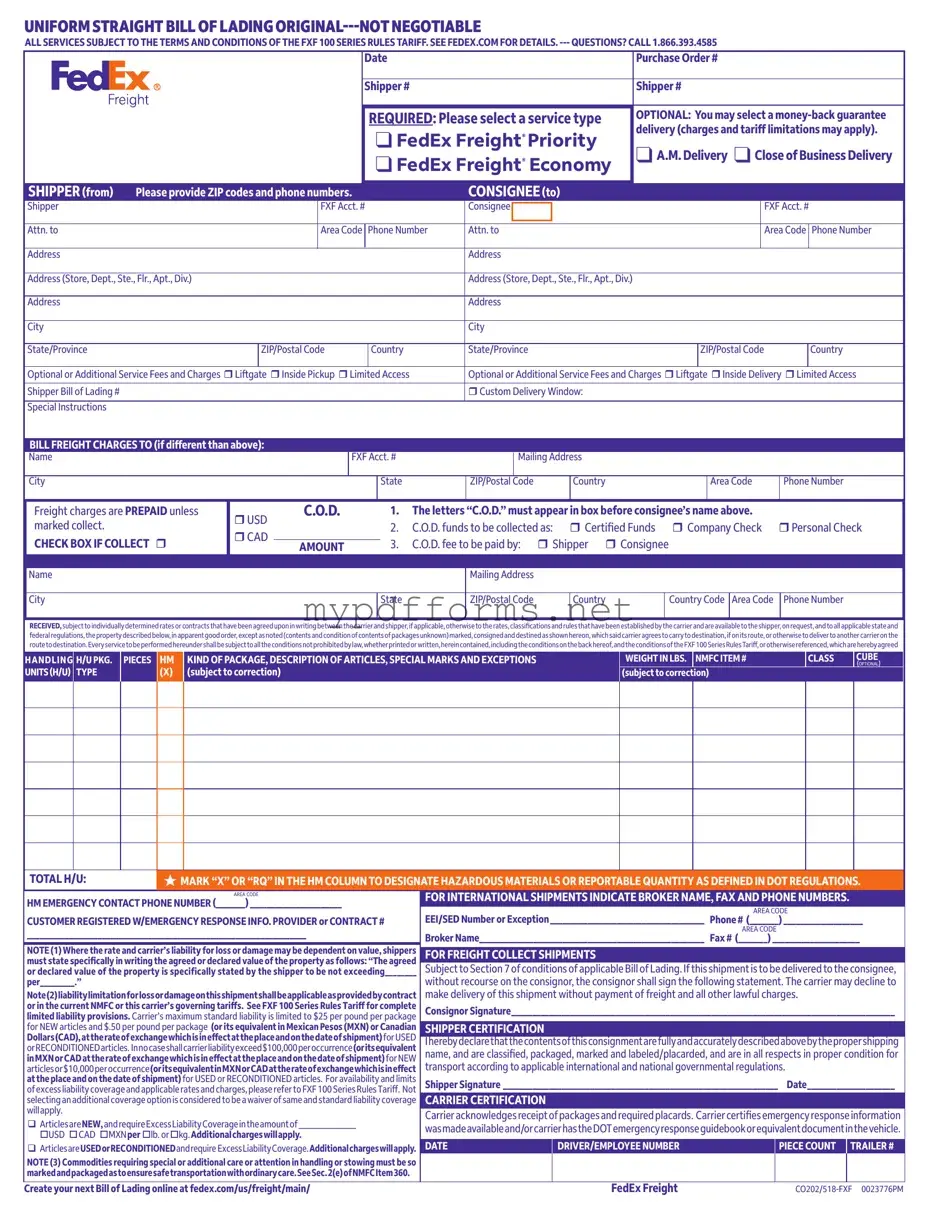The FedEx Bill of Lading is similar to a Standard Bill of Lading, which serves as a receipt for goods being transported. This document outlines the details of the shipment, including the shipper, consignee, and the type of goods being transported. Like the FedEx version, the Standard Bill of Lading also includes terms and conditions that govern the transportation of goods. Both documents ensure that the carrier acknowledges receipt of the goods and agrees to transport them to the specified destination.
Another comparable document is the Air Waybill, commonly used for air freight shipments. The Air Waybill acts as a contract between the shipper and the airline, detailing the shipment's particulars, including weight, dimensions, and destination. Similar to the FedEx Bill of Lading, it serves as a receipt and provides evidence of the agreement between the shipper and the carrier. Both documents also contain terms and conditions that govern the transportation process.
The Ocean Bill of Lading is also akin to the FedEx Bill of Lading, particularly for international sea freight. This document serves as a contract between the shipper and the shipping line, outlining the terms of the shipment. It includes details such as the type of cargo, shipping route, and delivery terms. Like the FedEx version, the Ocean Bill of Lading provides legal protection for both parties by specifying the responsibilities and liabilities involved in the shipping process.
A Consignment Note is another document that shares similarities with the FedEx Bill of Lading. Used primarily in road freight, this document serves as proof of the contract between the sender and the carrier. It includes shipment details, such as the sender's and recipient's information, and may also outline any special instructions for handling the goods. Both documents function as a receipt and a contract, ensuring that all parties understand their responsibilities.
The Delivery Order is a document that allows the consignee to take possession of goods from a carrier. This document is similar to the FedEx Bill of Lading in that it specifies the details of the shipment and confirms that the goods have been received by the carrier. Both documents provide a legal basis for transferring ownership and ensuring that the recipient has the right to claim the goods.
Understanding the various types of bills of lading is essential for anyone involved in the shipping industry, whether by air, sea, or land. Each document, including the FedEx Bill of Lading, the UCC Bill of Lading, and others, plays a vital role in ensuring that shipments are properly handled and responsibilities are clearly defined. For those needing specific documentation, resources such as Top Document Templates can provide valuable assistance in obtaining necessary forms tailored to your employment and shipping needs.
A Freight Invoice is often used in conjunction with the FedEx Bill of Lading. This document details the charges associated with the shipment, including freight costs and any additional fees. While the FedEx Bill of Lading outlines the terms of transport, the Freight Invoice serves as a request for payment. Both documents are essential for the financial aspect of shipping and provide transparency to all parties involved.
The Packing List is another document that complements the FedEx Bill of Lading. It provides a detailed inventory of the items being shipped, including quantities and descriptions. While the Bill of Lading serves as a contract and receipt, the Packing List ensures that the consignee knows what to expect upon delivery. Both documents help facilitate a smooth shipping process and minimize disputes over missing or damaged goods.
A Pro Forma Invoice is similar to the FedEx Bill of Lading in that it provides a preliminary bill for the goods being shipped. This document outlines the expected charges and can be used for customs purposes. Like the FedEx Bill of Lading, it includes details about the shipment and the parties involved. Both documents play a crucial role in international trade, ensuring compliance with regulations and facilitating the shipping process.
The Certificate of Origin is another document that can be compared to the FedEx Bill of Lading, particularly in international shipping. This document certifies the origin of the goods being shipped, which may affect tariffs and import regulations. While the FedEx Bill of Lading serves as a receipt and contract, the Certificate of Origin provides additional information that can impact the shipping process. Both documents are essential for compliance with international trade laws.
Finally, the Hazardous Materials Declaration is similar to the FedEx Bill of Lading in that it provides crucial information about the nature of the goods being transported. This document is necessary for shipments containing hazardous materials and outlines the safety measures that must be taken during transport. Like the FedEx Bill of Lading, it serves to inform the carrier and other parties about the specific requirements related to the shipment, ensuring compliance with safety regulations.
